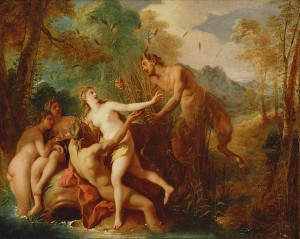In these posts I am trying to map out some of the distinct ways in which the Romantic spirit influences our culture before I try to tease out some of the connections between this and Christianity (yes, we’ll get there eventually).
In the last post I dealt briefly with the attraction of other times and places – observing, in particular the elevation of “primitive” life and childhood as embodying the Romantic idyll. But what is special about these “moments” in human life that make them so suitable for this dreaming?
Part of the answer is that they represent a more supposedly “natural” state of existence. Now this is a fairly problematic statement. In one sense, pretty much every philosophy and movement in Western believed in the pursuit of nature from Platonism through to deism and even atheism. The great problem for Western anthropology is how to deduce the true natural state of the human being when there are so many different forces acting on us and within us.
Nevertheless, for the Romantic, the answer to the problem is to look to nature at its most primal and least coerced. The richer “mode of life” that I spoke of in my definition of Romanticism is found in the untamed. Romantic artists produce paintings of rugged hills and deep forests and sunsets over distant oceans; Romantic poets find a mystical encounter with the sublime away from society; as they “[wander] lonely like a cloud” (Wordsworth) or “fade away into the forest dim” (Keats).
The mystical reaction to the natural environment also blurs into pagan nature religion. In 19th century Romanticism (and in the late neoclassical art that preceded the Romantic era proper), Pan, Greek god of mountain wilds, appears as a symbol of the mysterious sacredness of nature. In more recent times the same God (and others beside him) has reappeared in more literal form in the latest expression of the Romantic quest – neopaganism. The current most popular form of Western paganism known as Wicca generally envisages a vaguely Taoist style dualism in which the universal Goddess balances a male horned God. For modern Wiccans or witches Nature is literally magical – filled with an immanent spirituality that can be encountered and channelled through rituals, chanting and so on.
In the Craft, we do not believe in the Goddess we connect with Her; through the moon, the stars, the ocean, the earth, through trees, animals, through other human beings, through ourselves. She is here. She is within us all. She is the full circle: earth, air, fire, water, and essence body, mind, spirit, emotions, change.
(Starhawk, quoted in Pop Goes the Witch, ed. Fiona Horne)
Sex as divine
If Romanticism is characterised by a powerful emotional encounter with Nature then it is scarcely surprising that there is a special place for sexuality. John Keats in one letter proclaimed “Love is my religion–I could die for that.” Lord Byron (1788-1824), whose own personal life reads like Romantic pulp-fiction – woman after woman in exotic locations; death in Battle at the siege of Lepanto – gives us a view of his own idealised version of sex in his poem Don Juan. In one Canto his hero is washed up from a shipwreck and nursed back to life by a Spanish pirate’s daughter (arr).
A long, long kiss, a kiss of youth, and love,
And beauty, all concéntrating like rays
Into one focus, kindled from above;
Such kisses as belong to early days,
…The silent ocean, and the starlight bay,
The twilight glow which momently grew less,
The voiceless sands and dropping caves, that lay
Around them, made them to each other press,
As if there were no life beneath the sky
Save theirs, and that their life could never die.
…She loved, and was belovéd — she adored,
And she was worshipp’d; after nature’s fashion,
Their intense souls, into each other pour’d,
(Don Juan, Canto ii)
In modern psychological parlance we are talking about flowstate. Sex is cast as a mystical moment that blots out self and world – even the natural world around falls away. If we read on Byron assures us of the innocence and purity of the woman “she had never heard of promises to a spouse …She was all …pure ignorance and flew to her mate like a young bird” This of course is Rousseau’s myth of primitive innocence; instinct without the clutter of reason and knowing.
It goes without saying that this vision of Romantic love is very appealing and it has been taken on board almost wholesale by our own culture which – at its best believes in the dream of the one true soulmate who will finally complete us, and at worst looks to lose itself in simple phyiscal sex without attachment as the thing that gives colour and excitement to life. In music, film and literature sexual love is everything from the answer to meaning of life to the cure for a up-tight personality.
This time we go sublime
Lovers entwine-divine divine
Love is danger, love is pleasure
Love is pure-the only treasure
The power of love
A force from above
Cleaning my soul
A sky-scraping dove
(Frankie Goes to Hollywood, The Power of Love, 1984)
Once again neopaganism, sacralizes sex as part of its Nature worship. Witches such as Fiona Horne and Francesca Gentille describe the revival of ancient pagan fertility rites. At the feast of Beltane where couples pair off to mate in the open and “inspire the earth and its animals to be fruitful”. Horne suggests that instead of praying a prayer before going to bed you should “have an orgasm …and offer the energy to the universe where it can be put to even more good use”

